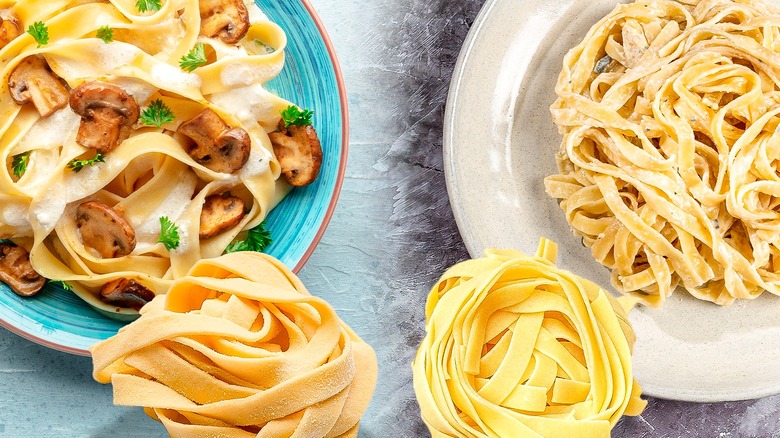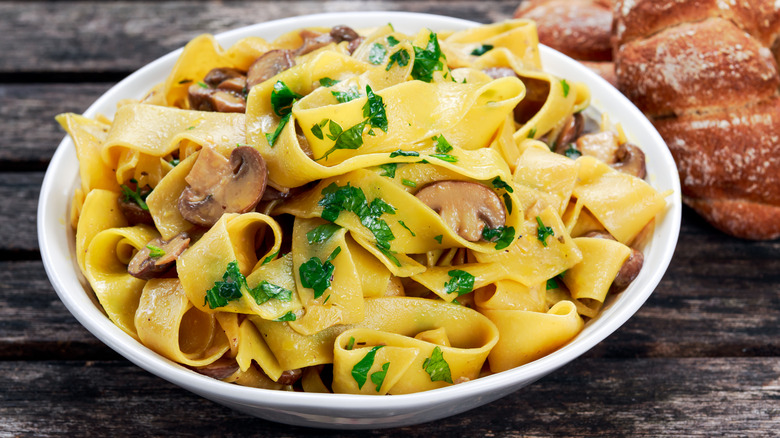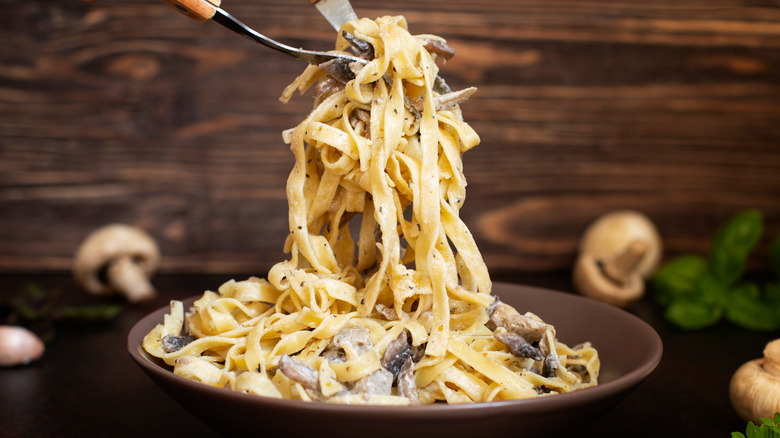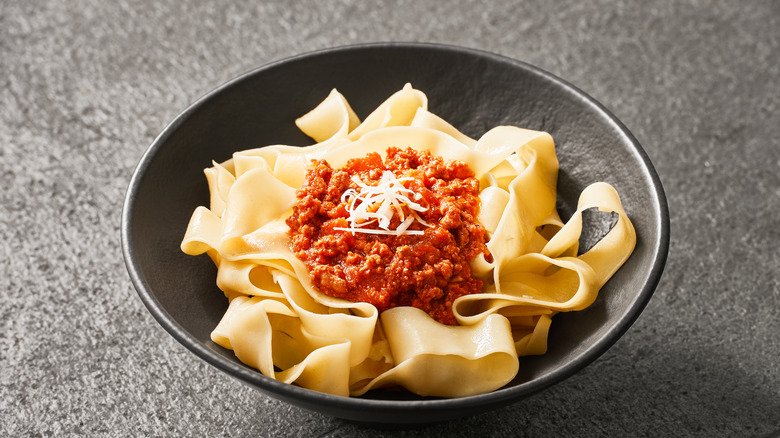What's The Difference Between Pappardelle And Fettuccine?
When it comes to Italian cuisine, pasta is one of the most ubiquitous foods. With dozens of pasta varieties to choose from, each brings its own unique charm and character, from shells and spirals to thin and wide sheets. When it comes to pappardelle and fettuccine, these two flat, long noodles can appear deceptively similar. A quick walk down the pasta aisle of your grocery store reveals just how alike the two types of pasta are. In fact, if it were not for the labels on the boxes and bags of pasta, the untrained eye might not be able to tell the two apart at all.
So, what sets these two pastas apart? Size and shape play a crucial role. You could use them interchangeably if that's what you have on hand or if it is your personal preference. There are, however, certain styles of sauces and overall dishes that are better suited to each style of pasta.
What is pappardelle?
Pappardelle is a wide, flat pasta with origins deeply rooted in Tuscany, the central region of Italy. The word pappardelle quite literally means "to gobble up," which couldn't be a more perfect name for such a delicious pasta. Today, pappardelle remains popular in Tuscany, and throughout the rest of Italy too. Of course, you can find this pasta in the United States as well, although it may be less prevalent than fettuccine.
Pappardelle pasta is a simple mixture of wheat flour and whole eggs, and sometimes a touch of olive oil is added to bring the dough together. Because pappardelle pasta is known for being a wider type of noodle, it is often served with chunkier, thicker sauces such as Bolognese (which is more robust when roasted in the oven). This is because the wider pasta has more surface area for heartier sauces to cling to, like in our fresh pappardelle with rustic tomato sauce. This pairing also works well together because the more substantial noodles can stand up to sauces that could overpower thinner, more delicate plates of pasta.
What is fettuccine?
Fettuccine hails from the neighboring region of Lazio, its name derived from the Italian word "fettuccia," meaning "little ribbons." This pasta is similar in shape to pappardelle but is narrower and thinner, offering a more delicate texture and flavor. Similarly, fettuccine is also made from wheat flour and eggs, which is why it appears to be so similar to pappardelle. Today, fettuccine thrives outside of its original region but is quite popular in Tuscany and Rome too.
As you likely guessed, fettuccine was popularized thanks to its part in the original fettuccine alfredo, but don't let that limit you to only using this pasta for the parmesan-based sauce. Fettuccine is also perfect for serving with a lighter ragu or meat sauce. While thinner than pappardelle, fettuccine is wider than noodles like angel hair or spaghetti. This makes it perfect for grabbing onto sauces that are not too heavy for this medium-width pasta.
Pappardelle cooks slower than fettuccine
Pappardelle is wider and thicker than fettuccine and has a rustic charm that makes it perfect for hearty, robust sauces. Its broad surface area does, however, require roughly twice the time to cook. On the other hand, fettuccine's slender profile, which is roughly half the width of pappardelle, allows it to cook quickly and evenly, ensuring a perfectly al dente texture.
When it comes to choosing between pappardelle and fettuccine, consider the sauce. Are you craving a hearty, stick-to-your-ribs kind of meal? Reach for pappardelle. Try making a vegetarian ragu with hearty mushrooms for a different spin on this heavier style of pasta. If you're in the mood for something lighter and more refined, fettuccine should be your go-to. Try dressing up your typical Alfredo recipe by adding steak. Or, turn it into a creamy and spicy dish with Tasting Table's Creamy Cajun Shrimp recipe.



